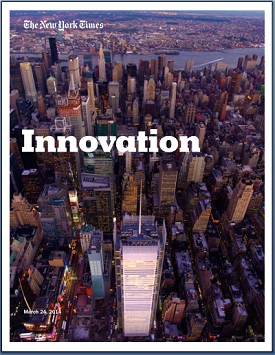
For those of us who have spent the past decade or two on the front lines of trying to make newspapers and other legacy news organizations more digital, the internal innovation report that leaked from The New York Times newsroom last week is fascinating – and more than a little depressing.
Viewed from the outside, The Times has been a clear leader in the digital news revolution: producing innovative storytelling projects such as “Snow Fall” and “Tomato Can Blues,” mounting a successful paywall strategy, pioneering on platforms like the iPad and Flipboard, pouring seemingly endless resources into digital R&D, employing scores of people whose primary jobs are in digital news. In its move to digital, as in its journalism, The Times appeared to be the industry’s gold standard. It was easy to be jealous.
On the inside, however, it appears that The Times’s digital makeover has been a mess – in ways that many of us are all too familiar with.
“…over the last year The Times has watched readership fall significantly. Not only is the audience on our website shrinking but our audience on our smartphone apps has dipped…” –New York Times “Innovation Report”
As has been the case elsewhere, most of The Times’s biggest, deepest wounds were self-inflicted, as attempts to graft a digital future onto a legacy print news operation have been hindered time and again by the shackles of 150 years of print-centric culture and processes. The print audience may only be a small fraction of the overall audience at the Times and other papers today (revenue is another matter), but the print mentality still has primacy in the way the Times and others are run. As long as there are both print and digital products coming out of the same newsroom, the natural internal tensions and conflicts may be too great to find a workable middle ground.

The 96-page “Innovation Report,” produced by an internal group after a six-month study, said readership at The New York Times had declined over the last year and concluded the company is “falling behind” rivals in audience development.
Here’s what the Times report says, right up front:
“Stories are typically filed late in the day [for print publication the next morning]. Our mobile apps are organized by print sections. Desks meticulously lay out their sections but spend little time thinking about social strategies. Traditional reporting skills are the top priority in hiring and promotion. The habits and traditions built over a century and a half of putting out the paper are a powerful, conservative force as we transition to digital – none more so than the gravitational pull of Page One.”
It sounds like 1997.
More: “It is essential to begin the work of questioning our print-centric traditions, conducting a comprehensive assessment of our digital needs, and imagining the newsroom of the future.”
Wow, isn’t it a little late for that?
And if the Times, for all its good digital work and voluminous resources, still is stuck in the past, what does that say about other newsrooms? Well, one important answer to that came in another report last week, from a group of journalists/researchers at the Duke Reporters’ Lab. The title gave the game away: “The Goat Must Be Fed.”
Writing about the slow rate of adoption of digital tools and data journalism by news organizations, Mark Stencel, Bill Adair and Prashanth Kamalakanthan painted a picture of newsrooms that look just as hidebound as The Times’: stuck in old cultures, slaves to antiquated daily production schedules, stymied by ineffective leadership.
“Many newsrooms just don’t have the bandwidth to even imagine where to start,” the Duke report said. “The deck is stacked against these newsrooms in multiple ways. They don’t have control, they don’t have the know-how and they don’t have the publishing systems they need to make full use of the tools that are available to them.”
…the Times innovation report represents much more than just a progress report on the Times’ transition to digital. It reflects the entire industry’s problems with the changeover.
Inherent in the title of the Duke report is the reality that all newsroom leaders grapple with these days: how to encourage and manage change and innovation, amid shrinking resources, when you’re still spending most of your time worried about getting out the daily print newspaper or broadcast news program. Yes, the damn goat must be fed. Every. Single. Day.
Or, as the Times report put it: “The experience of putting out the newspaper informs almost every element of how we do our jobs, from the people we hire to how they work to what they produce. These assumptions – based on the newspaper’s fixed dimensions and hard deadlines – are so baked into our days that it is easy to overlook their artificial limitations or the new possibilities we could embrace.”
Two decades into the digital news revolution, we still seem to be fighting the same old battles, trying to overcome deep-seated cultural issues that have stymied true innovation. Even more damningly, The Times and Duke reports are full of envious references to good work being done by more agile startup news organizations such as Vox and BuzzFeed, Quartz and Huffington Post that aren’t encumbered by the same legacy issues – or the need to tailor their newsroom processes to print production requirements.
Striking the balance between print and digital has been a major challenge for news organizations since the advent of online news in the mid-‘90s. Sadly, it appears we just haven’t made as much progress in remaking internal processes to support digital as many of us would have hoped — and not for lack of trying. The inertia of traditional newsrooms remains too hard to budge.
(One telling irony: a tweet last week suggested that the Times report was being printed out in newsrooms all over the country – proof in itself that newsrooms still default to print!)
The More Things Change, the More They Stay the Same
For more than 20 years, I’ve spent time on both sides of the equation. I’ve worked in or run red-headed stepchild digital news operations that had to fight for scraps of attention and respect from the print side. And I’ve overseen a modern combined print and digital newsroom where change still was limited by antiquated systems, change-wary staff members, lack of resources and consistent top management support and, yes, the daily requirement to feed that ravenous goat and make sure the printed newspaper came out every day—even though the time and resources devoted to print were vastly disproportionate to the dwindling size of the print audience.
So the Times innovation report represents much more than just a progress report on the Times’ transition to digital. It reflects the entire industry’s problems with the changeover. Everybody, it appears, is grappling with the same problems, even the great and powerful New York Times.
For those of us battle-scarred on the front lines of the digital news wars, the Times report was rife with passages that could have described newsrooms we’ve worked in:
- “Many of our traditions, routines and habits – perfect for the fixed deadlines and constraints of print – seem increasingly out of step with the digital world.”
- “The vast majority of our content is still published late in the evening, but our digital traffic is busiest early in the morning. We aim ambitious stories for Sunday because it is our largest print readership, but weekends are slowest online.”
- “We have not yet modernized [the] support system for our digital journalism.”
- “We look at our competitors through a print lens, as well. Newsroom leaders spend a lot of time reading other outlets’ stories. Few are studying their digital strategies.”
- “The newsroom has historically reacted defensively by watering down or blocking changes, prompting a phrase that echoes almost daily around the business side: ‘The newsroom would never allow that.’”
- “We are focusing too much time and energy on Page One. … Page One sets the daily rhythms, consumes our focus, and provides the newsroom’s defining metric for success.”
Echoes from the Duke report:
- “Many top editors and producers think of digital tools as extras – ‘bells and whistles’ that augment traditional story forms rather than primary story forms in their own right.”
- “Digital staffs still focus much of their energy on reproducing traditional news stories – digital versions of newspaper copy, ‘webified’ broadcast scripts, and repurposed TV and radio clips – rather than on producing unique digital features that can drive as much, or even more, traffic with deeper engagement and longer shelf-lives.”
- “Newsrooms have little technical expertise of their own, especially among their leaders.”
- “In the newsrooms where the technical know-how exists, inflexible editing and web publishing systems often make it difficult to share the stories that digital tools help tell.”

“The Goat Must Be Fed,” a new report from the Duke Reporters’ Lab, describes the many challenges faced by today’s newsrooms in adopting digital tools.
In other words, for all the challenges facing The Times and other news organizations, all the issues with declining circulation and advertising, all the problems with upstart competitors attacking what used to be a near-monopoly business, all the difficulties of trying to speed up to what we used to call Internet time, the biggest barriers to change have been tribal customs and ancient systems, along with stubborn newsroom denizens and well-meaning-but-clueless managers. The result: a change-resistant, technology-poor culture that just can’t get out of its own way.
…the ultimate answer for the Times and other papers may lie in the nuclear option: ditching print – or greatly minimizing it.
Also depressing in the Times report: the words of digital staffers who’ve left the newspaper in frustration over the bureaucracy, crappy technology, slow pace of decision-making, and the sheer inability to make a difference. Said one ex-Timesperson quoted in the report: “I wanted to learn from a purely digital company that didn’t have complicated print legacy requirements. I still feel to some extent that The Times, or large parts of The Times, have a begrudging acceptance of technology.”
Said another: “I looked around the organization and saw the plum jobs – even ones with explicitly digital mandates – going to people with little experience in digital. Meanwhile, journalists with excellent digital credentials were stuck moving stories around on section fronts.”
Ouch. We’ve all heard similar complaints from people who’ve fled legacy media in frustration over the pace of change. And again: This is The New York Times, which seemed to have mastered the digital world better than anyone else in the legacy camp and should be a great place to do great digital work. Still, it’s seen good people running for the exits.
A Classic Case of Innovator’s Dilemma
There was another insight last week into the industry’s problems with implementing sweeping change: an interview by American Press Institute’s Millie Tran with management guru Clayton Christensen, whose classic book “The Innovator’s Dilemma” is the fundament text for understanding how unexpected disruption from upstart competitors can violently upend staid, traditional organizations.
Nearly a decade ago, Christensen led a project for API called Newspaper Next that focused his methodology on the newspaper industry and offered detailed, significant prescriptions for change. Despite a massive evangelizing effort by Christensen and a handful of industry leaders, Newspaper Next was a notable flop, changing almost nothing.
What went wrong? “My sense of the Newspaper Next project is that people read it as an interesting, academic exercise but somehow, whether it was our fault or theirs, the report was consumed at the level of the brain and not the heart,” Christensen told Tran. “Most newspapers decided that might happen to others but it doesn’t happen to us.”
And there you go. Ignoring the threat, clinging to the old ways, hoping it’s the other guy’s problem, making tiny changes in longtime practices, failing to invest in technology and innovation, newspapers missed the boat on the digital revolution that has rocked their world in a perfect “Innovator’s Dilemma” storm.
Yeah, every paper these days has a website and an app and is doing video and tweeting, and the like. But with rare – if any – exceptions, there are no truly “digital first” newsrooms among legacy media the way there are at pure digital media companies like Vox and BuzzFeed. Instead, there are way too many places like The New York Times, making token – or slightly better – efforts at being digital, but still not truly changing their foundational culture and practices to adapt to the new, disrupted reality. (Hell, the Times report actually needed to spend the better part of two pages explaining to the newsroom audience what “disruption” is.)
It’s a wicked and pervasive problem that’s playing a big role in keeping traditional news organizations from being competitive with newer, less-encumbered competitors. And no, even after 20-plus years on the front lines, I’m not sure what the solution is. When the same newsroom produces print and digital products, the inherent conflicts seem to be just too overwhelming.
The Times innovation report, in addition to its candor about the problems the paper faces, also offers many smart, if belated, suggestions, from doubling down on a true “digital first” strategy that attempts to untie the knotty legacy newsroom issues to closer coordination and cooperation (horrors!) between the newsroom and business side of the paper, which is long overdue.
The Nuclear Option?
But the ultimate answer for the Times and other papers may lie in the nuclear option: ditching print – or greatly minimizing it – so that we’re forced to deal with the digital issues as our primary concern, not a secondary annoyance. Yes, I know the argument against this all too well: the bulk of advertising revenue still comes from print. But so do most of the costs, and almost all of the backward-looking cultural problems.

New York Times truck (Shutterstock)
A news organization that doesn’t have to worry about print production would be freed from all sorts of issues. Time-wasting debates about the cultural primacy of print vs. digital would instantly cease. Deadlines, staffing and production cycles can be wrapped around the news and fitted to audience demand, rather than tied to when the presses and trucks start rolling in the middle of the night. Supple, ever-changing web and mobile pages would replace the static, rigidly formatted print front page, with the news driving decisions, not the need to fill a broadsheet canvas.
The goat would no longer need to be fed – at least not in the same restricted-diet way.
How does this get paid for? Management focus and corporate culture have to be moved from defending print to aggressively finding ways to innovate and make online pay. Several years ago, Netscape founder Marc Andreessen – now a prominent venture capitalist who’s lately taken a deep interest in the future of news – had some radical thoughts on that subject. As it happens, the example he was using was none other than The New York Times. Asked what he’d do if he ran The Times, Andreessen said:
“Shut off the print edition right now. You’ve got to play offense. You’ve got to do what Intel did in ’85 when it was getting killed by the Japanese in memory chips, which was its dominant business. And it famously killed the business – shut it off and focused on its much smaller business, microprocessors, because that was going to be the market of the future. And the minute Intel got out of playing defense and into playing offense, its future was secure. The newspaper companies have to do exactly the same thing. … Shut off the printing press…. Then you play offense. And guess what? You’re an internet company.”
Andreessen’s dramatic proposal advocates a giant leap into the unknown. But as the Times and Duke reports demonstrate, incremental changes just aren’t doing the job. The savings from running presses and delivery trucks could be redirected to finding ways to make money online and through other means, such as events and data. If unencumbered papers can’t solve the revenue problem, they’ll die. But they’re dying anyway.
Shift to Mobile Increases Urgency
There’s now more urgency than ever for revolutionary change, not only with the print business continuing to decline and ongoing problems with finding replacement revenue streams. The digital game itself is quickly evolving around us, with mobile news and information products setting off yet another tsunami of change and challenges.

Source: Shutterstock
Today, the percentage of traffic to most news sites from smartphones and tablets is soaring past 50 percent; the Times’s mobile readership is at almost 60 percent, according to the report. That means we’re seeing a rapid, yes, disruptive switch from the web to mobile as the primary medium we talk about when we say “digital.”
The Times report mentions mobile, but its emphasis still seems to be on trying to figure out the web. It may be too late for that. At least the report says, “Instead of running mobile on autopilot, we need to view the platform as an experience that demands its own quality control and creativity.” Ya think?
And it concedes, “At a time when nearly 60 percent of our readers access us via mobile devices, we are missing an opportunity to serve up content that’s relevant to their locations because we are not tagging stories with geographic coordinates” – another symptom of chronically failing to refashion basic processes to exploit potential digital benefits.
In other words, it’s not just about being more creative digitally and spending less time worrying about what’s on Page One; what’s needed is a top to bottom newsroom rethink of content forms, workflows, technologies and products to adapt to a rapidly changing world. And not just in the newsroom – advertising sales, marketing and circulation efforts need to be rebuilt from the ground up as well.
In 2014, at The New York Times, the industry’s flagship, that still hasn’t happened. Nor has it happened in most other places, if any.
Again, there appear to be no easy solutions to these issues, especially in a time of ongoing financial stress. Just in the past few weeks, one of the newspaper industry’s most ambitious efforts to get ahead of the digital curve, Digital First Media and its Projects Thunderdome and Unbolt, which ambitiously aimed to remake the company’s news operations and refocus its newsrooms on digital production rather than print, came apart at the seams under pressure from the company’s impatient bankers. Digital First CEO John Paton, an industry visionary who not long ago warned journalists to stay away from a news company not investing heavily in digital efforts, found himself forced to cut back his own company’s digital investment and lay off dozens of talented digital journalists. Oops.
For sure, some papers have done better than others – maybe even better than the Times – in grappling with the transition to digital. But if, as the Times and Duke reports suggest, we’re still trapped by many of the same structural problems that bedeviled legacy newsrooms back at the dawn of the digital news age, then we still have a very long way to go. And under unrelenting disruptive assault, the traditional news industry, even with best intentions, may just not have the time to get there.








Leave a Comment